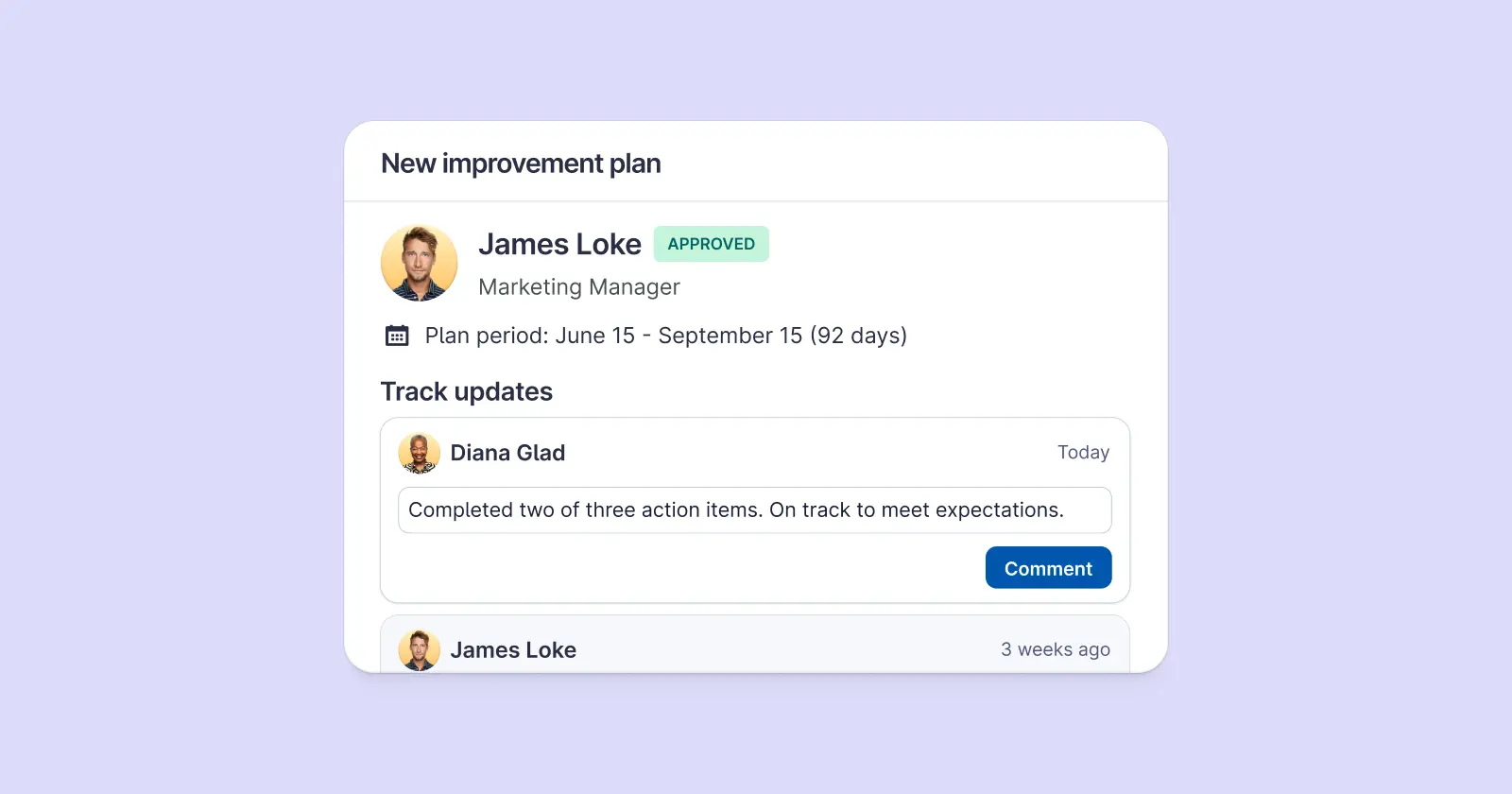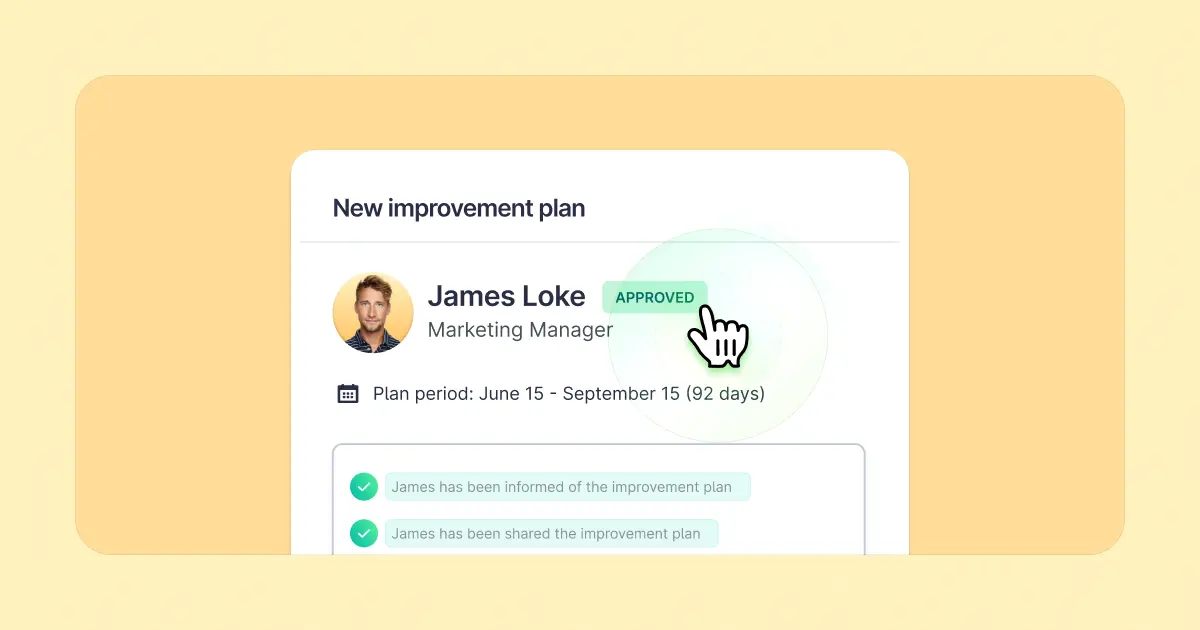Even with a great culture and a high-performing team, you’ll eventually run into a tough situation: Someone keeps missing deadlines. Or skipping shifts. Or behaving in a way that makes others uncomfortable.
At some point, you have to step in — not just with a quick chat, but with a formal written warning.
And let’s be honest: It feels awkward.
You want to be firm but fair. You want to protect the team without coming off as punitive. You want to support your employee without downplaying the seriousness of the situation.
It’s a balancing act. When it’s done well — calmly, professionally, and clearly — a written warning can actually help. It can set boundaries, clear up confusion, and give someone a real shot at turning things around.
That’s why it’s so important to have a consistent process. A written warning template won’t make a hard conversation easy, but it can help you stay grounded and handle the moment with care.
What is a written warning?
A written warning is a formal document that tells an employee there’s a serious issue they need to address, such as a behavioral problem, a performance concern, or a company policy violation.
It usually comes after other steps, like a private chat or a verbal warning, but not always. If someone behaves in an extremely inappropriate way or violates a safety policy, you might need to skip straight to a written warning.
The purpose isn’t to punish. It’s to make expectations clear. A good written warning outlines what the issue is (for example, poor performance on a critical project or ongoing unprofessional conduct), what needs to improve, and by when.
When handled well, a written warning gives employees a clear path to improve and stay in their role. It also helps employers document issues consistently in case further action is needed later. That documentation should align with your employee handbook, company policies and values, code of conduct, and any relevant employment laws.
A written warning needs to be part of a two-way conversation, where the employee has a chance to share their side of the story, ask questions, and respond without fear of retaliation. Tools like Lattice Feedback can make it easier to document that conversation and keep the process fair and transparent.
Written Warning Template
Using a written warning template helps you stay consistent and avoid any sense of unfair treatment. It ensures you cover the essentials without letting emotion or personal judgment creep in.
For example, if two employees repeatedly miss deadlines, the template makes sure you address both situations the same way, with clear expectations and timelines. It also gives you a record you can refer back to when checking in on progress.
{{rich-highlight-1}}
What a Written Warning Template Should Include
You can adapt the template to meet your business’s needs, but here’s an overview of what to include:
Employee information:
- Employee name
- Company name
- Job title
- Date of the employee warning notice
Manager information:
- The name and title of the supervisor or manager the employee reports to
Description of the issue:
- A clear summary of the specific behavior or performance issue
- Key dates and times
- Any existing patterns of behavior
Policies and standards:
- Details of which company policies, procedures, or conduct standards the employee has violated or failed to meet
Previous actions:
- Details and dates of any previous warnings or interventions, such as verbal warnings or coaching
Expectations for improvement:
- Details of what corrective action the employee needs to take
- Any interim dates or checkpoints for tracking progress
Employee feedback:
- Any feedback from the employee or their representative about the warning
Dated signatures:
- Employee’s signature, to confirm that they’ve received and understand the warning and expectations (even if they don’t agree with it)
- Supervisor’s signature
- HR representative’s signature
- Signatures of any third-party witness or union rep
Follow-up plan:
- Date for a formal review of the employee’s progress
- Suggested next steps, depending on how the employee has responded
A customizable written warning template like Lattice’s helps you ensure all your teams are on the same page when it comes to giving written warnings.
When is a written warning useful?
How do you know when it’s appropriate to give an employee a written warning?
Here are common scenarios where a written warning may be justified, along with factors to consider before issuing one:
Absenteeism or Time-Related Issues
- When is a written warning justified? You have an employee who has shown repeated tardiness — consistently arriving late to work, returning late from lunch. Or perhaps you’ve noticed a pattern of unexplained, unauthorized absences. Maybe they repeatedly use work time for personal activities. You’ve already spoken to them and explained what needs to change, but it hasn’t happened.
- What to consider before giving a warning: Check the employee’s attendance records and review the team's productivity metrics, so that you have the specifics to make your case. Make sure that they are familiar with how the employee attendance policy relates to their circumstances.
- How should management be involved? Ask the employee’s manager for records, but also for context. Is this a new pattern or an ongoing issue? Has the employee brought up personal challenges? Has there been any improvement after earlier conversations?
The manager should be part of shaping the warning. They should also be responsible for tracking whether attendance improves and following up regularly.
Performance Shortcomings
- When is a written warning justified? Your employee’s performance is consistently falling short of expectations or targets. You’ve offered coaching or feedback, but it hasn’t led to the kind of sustained improvement you need to see.
- What to consider: Gather whatever performance metrics, missed deadlines, or work quality concerns you need to support your case. Compare these to the employee’s individual key performance indicators (KPIs), performance reviews, and any other relevant records.
- How should management be involved? Start by getting input from the employee’s manager. They’ll have the clearest view of what’s been happening day to day. Ask for examples of underperformance, what support has already been offered, and how the employee responded. Work with them to shape the written warning letter so it’s fair, accurate, and constructive.
Ideally, the manager should also be present when the warning is delivered and take the lead on setting a clear improvement plan with specific goals and check-ins. And they should continue to document follow-up conversations, progress, or ongoing problems after the warning is issued.
Violation of Company Policies or Values
- When is a written warning justified? The employee has misused company resources, committed a relatively minor health and safety violation, or behaved inappropriately with a colleague or customer in a way that violates company policies or goes against the values of the company.
- What to consider: Evaluate the severity of the violation. For example, was it intentional or simply careless? Is it an isolated infraction, or is there a pattern? What is the impact on the business or the employee’s team or work?
- How should management be involved? The employee’s manager can help collect incident reports, witness statements, or emails. They should also confirm whether the employee had reviewed relevant policies during onboarding or training. After the warning is issued, the manager should keep an eye on behavior going forward and reinforce expectations regularly.
Insubordination or Rudeness
- When is a written warning justified? An employee has refused to follow reasonable instructions from their team leader, or they behaved in a disrespectful way toward management.
- What to consider: Be sure to take the context into account. For example, was the request to the employee clear and appropriate? Was there a possible misunderstanding or crossed wires? Also, consider if there is any precedent or if this is an isolated incident.
- How should management be involved? The manager should document exactly what happened, how the employee responded, and any previous attempts to address the issue informally. An HR professional should be looped in quickly if the situation seems likely to escalate or involve more serious consequences.
Data Confidentiality or Breaches
- When is a written warning justified? While serious mishandling of confidential information could be grounds for immediate termination of employment, a written warning could be warranted for more minor or careless lapses around sensitive information.
- What to consider: Was it a simple mistake or a sign of carelessness? Did it put client data, internal strategy, or team trust at risk? Check whether the employee received proper training on confidentiality, and whether that training was recent and relevant.
- How should management be involved? Partner with the employee’s manager and, if necessary, IT or legal to assess the impact and document the breach clearly.
{{rich-highlight-2}}
What is the procedure for issuing a written warning?
To avoid any legal or internal headaches, you need a clear, repeatable written warning workflow.
Your disciplinary process should also be spelled out in your employee handbook and reinforced during onboarding, so there are no surprises when issues come up.
Below is a step-by-step guide you can adapt to fit your team, your policies, and your tone:
1. Document the issue.
Get your facts and data together. This could include attendance records, emails, reports, or statements from colleagues.
An HRIS system like Lattice HRIS can make it easy to pull in the employee’s performance data and coaching and feedback history from their profile.
Consult the employee handbook, company policies, job description, and code of ethics to analyze how the employee has stepped out of line or fallen short of expectations.
2. Determine if a written warning is warranted.
Discuss the issue with the relevant line manager. Review the employees’ history, the seriousness of the infraction, and whether previous disciplinary action has been taken.
Consider whether there are other avenues, such as coaching, that would be more appropriate to explore first.
Check if written warnings have been given to other employees for similar behavior. You don’t want to face accusations of bias or favoritism.
3. Prepare the written warning.
Gather all the details and documentation you need to include in your written warning. Depending on the issue, this could include:
- Attendance records
- Performance records and KPIs
- Complaints or witness statements
Draft the written warning document using the customizable template above.
4. Conduct a formal meeting.
Invite the relevant people to a formal meeting. In addition to the employee, HR rep, and line manager, this could include a neutral third party or a union representative, if relevant.
Present the facts to the employee as you understand them, and explain why a written warning is appropriate in the circumstances. Make sure to be neutral in your tone, and don’t accuse.
Give the employee space to respond and ask questions.
Talk them through the written warning template, explaining each section and how it affects them. Set out your expectations for improvement, give them the timeframe to achieve it, and outline the potential consequences if there’s no change.
Set a date for a follow-up meeting.
5. Sign and file the written warning.
Ask the employee to sign and date the written warning. Be sure that they understand this is a simple acknowledgement of receipt — they do not necessarily have to agree with it.
If they refuse to sign, simply acknowledge that fact in the same non-accusing tone. Make a note of the refusal on the document and ask a witness (their manager or a neutral observer) to sign it.
Make sure that their manager and human resources rep also sign and date the form.
Attach the written warning to the employee’s personnel file in your HRIS for future reference.
6. Follow up.
After issuing the warning, monitor how the employee progresses in collaboration with their manager.
Decide what next steps should be taken. If they’ve shown the behavioral improvement you hoped for, you might want to close the issue. If not, it could be time to consider a second employee warning letter or other disciplinary action.
Conduct the follow-up meeting on the agreed date. Discuss your observations in a neutral tone. Acknowledge positive efforts and mention anything that falls short of expectations.
{{rich-highlight-3}}
Pros and Cons of Progressive Discipline for Employees
Written warnings are typically part of a progressive discipline system, which gives employees the chance to correct any behavioral or performance issues at an early stage, before they call for further disciplinary action.
The typical steps include informal coaching or verbal warnings, written warnings, a final written warning or performance improvement plan (PIP), and suspension or termination.
Like any system, it has its pros and cons. Here’s what to keep in mind.
Pros of Progressive Discipline:
- It gives you a consistent, standardized approach. Employees with similar issues are treated the same way, reducing the risk of bias or discrimination.
- It creates a clear paper trail. Every step is documented, so you can show exactly what actions were taken and why, which is helpful for HR, legal compliance, and internal accountability.
- It focuses on improvement, not punishment. For example, if a normally solid employee suddenly starts delivering unsatisfactory performance, progressive discipline gives you space to support them before jumping to drastic action.
- It gives employees agency. They know what’s expected and what needs to change, and they have a chance to respond and improve.
- It builds a more trusting work environment. When people see that issues are handled fairly and transparently, they’re more likely to raise concerns and stay engaged.
Cons of Progressive Discipline:
- It can be too rigid. Some situations require nuance, such as when a one-off mistake has a big impact.
- There’s a risk of box-ticking. An employee might do just enough to “pass” each stage without actually improving long-term, which slows resolution and drains team energy.
- Even with a process, human judgment still plays a role. That leaves room for inconsistency or unintentional bias, especially if managers interpret the policies differently.
- It doesn’t cover every scenario. For example, interpersonal dynamics, passive-aggressive behavior, or poor cultural fit might not trigger formal steps, but still require action.
- It can feel slow when a serious issue is unfolding. In some cases, you may need to act faster than the process allows.
{{rich-highlight-4}}

Lattice's free written warning template provides comprehensive details for documenting an incident, employee statements, and HR and manager sign-offs.
Improve your employee conduct processes with Lattice.

No one loves giving — or getting — a written warning. But when they’re handled with transparency, consistency, and respect, they don’t have to damage trust. In fact, a well-documented written warning can open the door to honest dialogue and real improvement.
Lattice gives you the tools to build a culture of ongoing feedback, where performance issues are spotted early and addressed constructively, long before a formal warning is needed. And when that step is necessary, having a clear, standardized process helps protect your people and your company.
Download Lattice’s digital written warning template and our disciplinary action policy template to make sure your process is fair and easy to follow.
Want to learn how Lattice can support your managers and your HR department? Request a demo.










